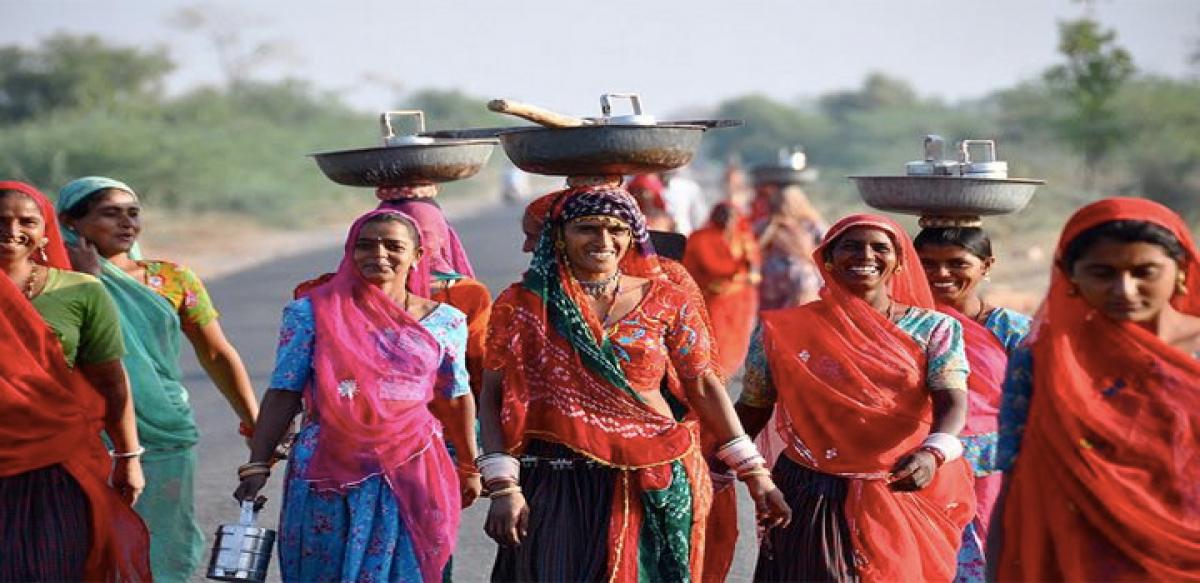Live
- Hari Chandana’s Green Initiatives: Transforming Hyderabad for a better Future
- Gangavati railway station to be renamed Anjanadri: MB Patil
- Bhool Bhulaiyaa 3 Continues to Dominate the Box Office, Grossing Rs 247 Crore
- Nature’s Basket opens B’lore’s largest artisan pantry store
- Top Strategies for Achieving Work-Life Balance and Well-Being
- PM Modi appreciates Early Bird’s efforts
- Wait for big meal at Indira Canteens ends in dismay
- Fishermen in distress due to lax sanitary facilities in Malpe Fisheries Harbour
- BJP, JD(S) leaders helped win Channapatna bypoll
- INS Kuthar makes maiden visit to Gopalpur Port
Just In

Thy name is woman!” said Shakespeare. Women of modern India proved Shakespeare wrong. But, women— who “hold up half the sky”— are yet to be empowered to take their rightful place in the socio-economic fabric of the country. India is somewhat of a paradox on gender issues. On one hand, India has had prominent and visible women leaders such as a female President, a female Prime Minister,
Frailty, Thy name is woman!” said Shakespeare. Women of modern India proved Shakespeare wrong. But, women— who “hold up half the sky”— are yet to be empowered to take their rightful place in the socio-economic fabric of the country. India is somewhat of a paradox on gender issues. On one hand, India has had prominent and visible women leaders such as a female President, a female Prime Minister, several female heads of large political parties at the national and the state levels, several Cabinet rank ministers, and several captains of industry (particularly in the banking sector).
And yet, according to the latest UNDP’s Human Development Report, India ranks 127 out of 152 countries on the Gender Inequality Index (GII). The GII is a composite measure reflecting inequality in achievement between women and men in three dimensions: reproductive health, empowerment and the labour market. This puts India in the bottom 20 per cent on the GII.
The India Exclusion Report highlights the continuing gender discrimination in India despite women making notable advances in many fields. Up to 43% of women in the working age (about 153 million) in India only do domestic work, indicating the scale of their exclusion from the workforce. Nearly half of all homes (47%) lack piped drinking water and sanitation, putting enormous physical and psychological stress on women.
The World Bank report entitled, Promoting Women’s Economic Participation in India, noted: “Despite rapid economic growth, gender disparities in women’s economic participation have remained deep and persistent in India.” Increases in reservations for women in rural and urban local self-government have gone a long way in increasing political participation for women. But deep-rooted gender biases still mar women from performing their constitutional responsibility independently.
Women still comprise a miniscule proportion of parliamentarians and legislators when compared to their share in the electorate. In both rural and urban India, women are not present in significant numbers in the labour force, according to the Economic Survey 2015-16.
Even though the proportion of the economically active population (15-59 years) increased from 57.7% to 63.3% between 1991 and 2013 (Sample Registration System data, 2013), “the labour force participation rate for women is significantly lower than that for males in both rural and urban areas” said the Economic Survey.
Women in India represent only 24% of the paid labour force, as against the global average of 40%, as per a recent McKinsey Global Institute report. At 53 percentage points, India has one of the worst gender gaps (disproportionate difference between the sexes) in the world when it comes to labour force participation, World Bank data shows.
Of the total sterilisation operations performed in 2012-13, tubectomy/laproscopic sterilisations account for 97.4 per cent, while male vasectomy operations, considered less risky, account for only 2.5 per cent. This shows the mindless violence inflicted on women in India. Gender disparities in economic participation remain deeply entrenched. Improving the status and treatment of women is a major development challenge.

© 2024 Hyderabad Media House Limited/The Hans India. All rights reserved. Powered by hocalwire.com







